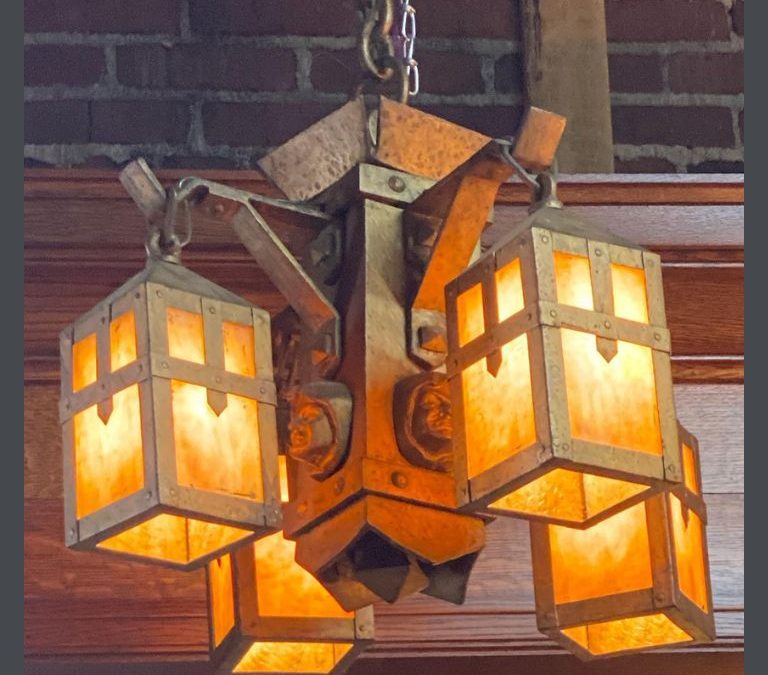
by bungalow101 | Jan 11, 2023 | Bathrooms, Doors & windows, Kitchens
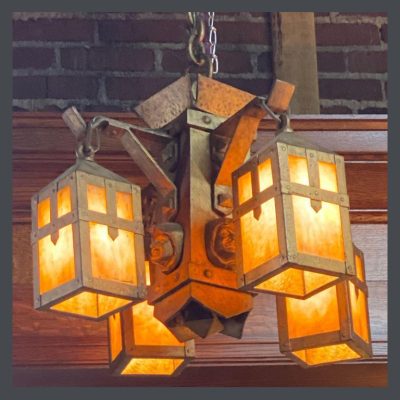 If you should be fortunate enough to have a bungalow, architectural salvage can be your BFF. Merriam Webster defines salvage as “property saved from destruction in a calamity (such as a wreck or fire).”
If you should be fortunate enough to have a bungalow, architectural salvage can be your BFF. Merriam Webster defines salvage as “property saved from destruction in a calamity (such as a wreck or fire).”
Cambridge adds, “to try to make a bad situation better.”
Not surprisingly, the derivation is from the French, “to save.”
Personally, I consider the destruction of a historic building, by Mother Nature, Father Time, or the hand of Man to be a crushing calamity & I have spent my adult life trying to get people to understand their value.You can read my story here.
There are so many arguments against it financially, culturally & aesthetically that it both puzzles & pains me that our built heritage is destroyed so casually. Whether by neglect, natural disaster or ignorance & short-sighted greed, the stories of our communities are turned to rubble & to dust.
Making lemonade, making “a bad situation better,” out of this sour mess, are those who are involved in architectural salvation. Architectural salvage involves carefully removing materials from a historic (or even a newer) structure that is going to be remuddled or completely destroyed. Instead of ruining these materials, & sending them to the landfill, salvagers give them a new life. Here’s a page of recommended by my Facebook followers outlets all over the U.S.
ARCHITECTURAL SALVAGE IS GREEN
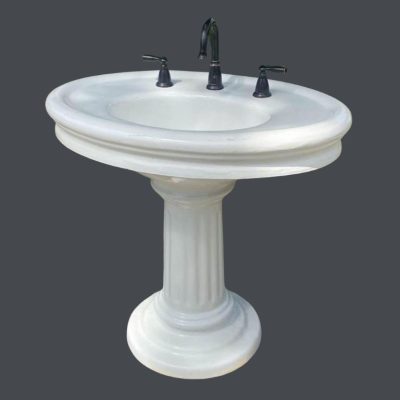 The footprint of architectural salvage materials is generally only that of transportation, from the original site, to the warehouse, to the new home. (hm-m-m.) I don’t think transportation is figured into the numbers for the turbine or for the panels.) This of course varies considerably so I’m not going to give you any figures on this but I think you get it!
The footprint of architectural salvage materials is generally only that of transportation, from the original site, to the warehouse, to the new home. (hm-m-m.) I don’t think transportation is figured into the numbers for the turbine or for the panels.) This of course varies considerably so I’m not going to give you any figures on this but I think you get it!
My buddy, Doc, of Doc’s Architectural Salvage and Reclamation Service, outside of Nashville, who provided me with all these gorgeous images, (including the PG one, is a master of the art. His well-ordered, abundantly stocked shop, Architectural Salvation is 38,000 sq. ft. of fine salvaged materials from homes, churches & commercial buildings & even ships. He & his crew have meticulously extracted these items from doomed structures, hauled them to his shop, cleaned & repaired them & offer them for sale to those who understand & appreciate their value.
I’m not going to try to ‘splain about Doc or Doc’s Architectural Salvation to you here when his website & social media do a good job of it. However, in the interest of full disclosure, Doc allows me to use his images for my blog & social media & buys me tacos when I visit him for the mention. I love tacos.
Please visit the BUNGALOW ARCHITECTURAL SALVAGE RESOURCES page to see outlets from all over the U.S. that were recommended by my Facebook followers. I encourage you to add the ones that you like the best too. Just scroll on down to the comments section.
 STAY IN THE BUNGALOW KNOW!!!
STAY IN THE BUNGALOW KNOW!!!
Sign up for our newsletter & receive our FREE E-book, 7 VITAL Things to Do Before You Hire a Contractor.
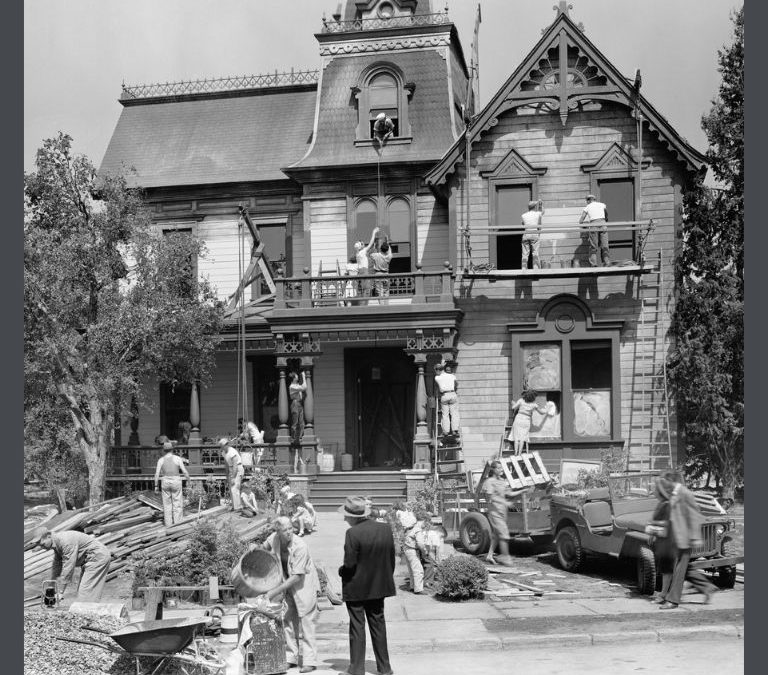
by bungalow101 | Dec 27, 2022 | Doors & windows, The History
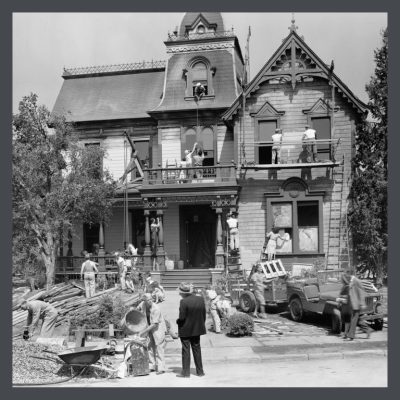 From their framing to their siding to their doors & windows to their built-ins & their flooring, our old houses, are built of old growth wood. Thousands of board feet of it.
From their framing to their siding to their doors & windows to their built-ins & their flooring, our old houses, are built of old growth wood. Thousands of board feet of it.
“Old growth.” What does that mean?
Let’s have a tree history lesson. Fossils show that the first tree-like plants, with vascular systems that transported water & nutrients, allowing the plants for the first time to rise up off the ground (Think moss.) & to form trunks & branches, developed 400 million years ago. Their evolution since then included the development of seeds & true woody stems.
Then,
Over 300 million years ago: The earliest conifers (i.e., cedar, fir, pine, redwoods & others) appear.
67 million years ago: Evidence of the first maple trees.
56 million years ago: Evidence of the first oak trees.
They continued to evolve & to create the great forests that covered most of America, generation after generation contributing to the next as they produced seeds, died & decayed, becoming part of the rich soil of the virgin woodland.
REDWOODS- THE LONGEST LIVING OF OLD GROWTH WOOD
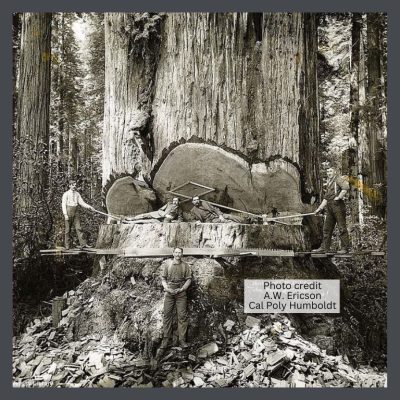 Let’s start with the Redwood, one class being the oldest plants on earth, living from about 800 to 3,200 years. On the west coast, before they were chopped to build our houses, they played an important part in the lives of early indigenous peoples who revered them, building structures from fallen trees. Native elder Minnie Reeves called them “a special gift from the Great Creator. Destroy these trees and you destroy the Creator’s love . . . and you will eventually destroy mankind.”
Let’s start with the Redwood, one class being the oldest plants on earth, living from about 800 to 3,200 years. On the west coast, before they were chopped to build our houses, they played an important part in the lives of early indigenous peoples who revered them, building structures from fallen trees. Native elder Minnie Reeves called them “a special gift from the Great Creator. Destroy these trees and you destroy the Creator’s love . . . and you will eventually destroy mankind.”
When California became a state in 1850, there were nearly 2 million acres of redwood forest. San Francisco was built twice with redwood, before & after the quake & fire of 1906. But the worst was yet to come. During the first half of the 20th Century when California experienced a major building boom, the redwood forest suffered its greatest losses, with trains of lumber heading south as trains of oranges headed north.
Going into the 21st Century, only 5 percent of the old growth forest still stood, thankfully protected on public lands.
In modern times, redwood farms produce wood for lumber, however, this new wood does not have the same high levels of toxic tannins, a type of bitter, astringent chemical compounds which protect the trees from fungus & insects & decrease its susceptibility to rot.
Selective cutting of young trees is permitted on redwood farms but these trees do not have enough age on them to acquire the decay & insect resistant properties of the old growth. If you want the original, old growth wood, you must buy it second-hand, salvaged from old buildings that some uninformed person has chosen to demolish.
OTHER OLD GROWTH CONIFERS IN OLD HOUSES
The Douglas fir forests of the Northwest were treated just as casually. The timber industry, both logging & milling’ developed into a huge industry. The quantities were regarded as unlimited, if they were regarded at all in the push to maximize profit. As harvesting & transportation technologies developed, so did the quantity of forest land destruction increase.
It wasn’t until the 1880’s that conservation of timber supplies was considered. National forests were established & research into good forest practices began.
OAK
 The Domesday Book of 1086, a survey ordered by William the Conqueror to record his holdings, indicated a forest cover of 15%, By the start of the next millennium, this coverage had dropped to 5%.
The Domesday Book of 1086, a survey ordered by William the Conqueror to record his holdings, indicated a forest cover of 15%, By the start of the next millennium, this coverage had dropped to 5%.
In the 17th Century, as thousands of colonists arrived in the United States from England, they placed heavy demands on the forests taking huge trees, some hundreds of years old, of many species for lumber not only for building but also for fuel. Additionally, they cleared lands for agriculture & livestock.
Additionally, after the Industrial Revolution, potash, potassium carbonate derived from burned wood was in high demand in the colonies & in England where they had already decimated their forests. By the early 1800’s, the pre-revolutionary American colonies were providing England with more than 60% of its potash.
The construction boom after WW I, especially during the mid-1920’s, furthered reduced our forest resources. You can read about pine’s story, in the forests of the Eastern U.S., here.
FARMED WOOD VS OLD-GROWTH WOOD
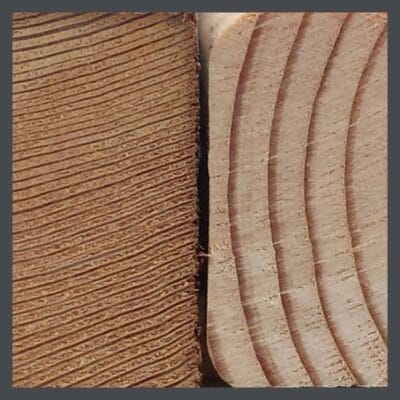 Trees are planted in man-made forests with the purpose of generating a large amount of product, fast. These farms do not replicate the ecology of the natural forest. Generally they are one species only, & all the trees are planted at the same time. The trees are planted in rows spaced to allow maximum sunlight & water exposure so they grow very fast. The old forests allowed trees to grow slowly, putting on more tightly-packed growth rings
Trees are planted in man-made forests with the purpose of generating a large amount of product, fast. These farms do not replicate the ecology of the natural forest. Generally they are one species only, & all the trees are planted at the same time. The trees are planted in rows spaced to allow maximum sunlight & water exposure so they grow very fast. The old forests allowed trees to grow slowly, putting on more tightly-packed growth rings
Because of this, new growth wood does not have the strength, stability nor the decay & insect repelling properties of old growth wood- not to mention the beauty. But. stick with me here. I have a theory about additional environmental factors that made the virgin forests a much better place for trees.
The conditions in the old forests had evolved over millions of years. Co-evolution is the evolving of all the parts of an ecosystem to assist each of its parts survive better. i.e., evolutionary change over time, benefiting each interacting member, usually involving different species. Tree farms lack this dynamic. They are the new kids in school without a support system, not oriented to their environment, & growing in unnatural conditions.
The virgin forest is home to many tree species as well as hundreds of different insects, animals & microbes. All of these organisms have made reciprocal adaptive changes in cooperation with one or more other species, over the millennia, helping one another to survive with greater & greater efficiency.
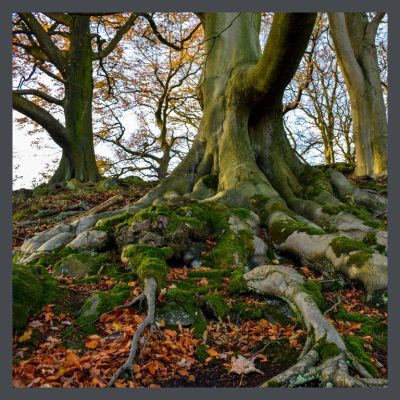 Much of this mutual adaptation involves microorganisms, the fungi that break down the fiber of the dead trees & turn them into nutritious soil, but also form a communication network for the trees. Watch this short video by National Geographic that explains how trees connect & share with one another.
Much of this mutual adaptation involves microorganisms, the fungi that break down the fiber of the dead trees & turn them into nutritious soil, but also form a communication network for the trees. Watch this short video by National Geographic that explains how trees connect & share with one another.
Trees do not stand alone, competing with one another for sunlight, water & nutrients. Rather, the forest is almost like a single organism, the different trees interacting with one another, both within & outside their own species, through their roots & the fungal networks that connect these roots. They exchange communication & nutrients through this network, with the larger, old Mother trees forming the hubs. As an example, Douglas firs share excess sugars with the leafless birches in the spring & fall, & in return, the birches send sugars to the Douglas-firs in the summer, via the fungi underground.
Here’s my crazy theory. The health of the human body depends on the quantity & diversity of the microbes that live in the gut. To build a strong, healthy body, one needs a strong healthy microbiome- the colony of microorganisms within the body. This is a lovely short video of 2 Stanford researchers who have discovered much of what is known in this science. They have a big picture of bacteria over the fireplace in their home.
My hypothesis is that lumber from a tree grown in the virgin forest is better, stronger, more stable, more decay & insect resistant not just because it is old & bigger, but because it has grown up with a Mother, a family, neighbors & friends in the form of an active ecosystem that has had millions of years to get it right. “It’s not better because it’s old, it’s old because it’s better.”
What do you think?
FOR MORE INFORMATION ON OLD GROWTH WOOD, VISIT OUR OLD HOUSE RESTORATION VIDEOS- OLD GROWTH WOOD here.
 STAY IN THE BUNGALOW KNOW!!!
STAY IN THE BUNGALOW KNOW!!!
Sign up for our newsletter & receive our FREE E-book, 7 VITAL Things to Do Before You Hire a Contractor.
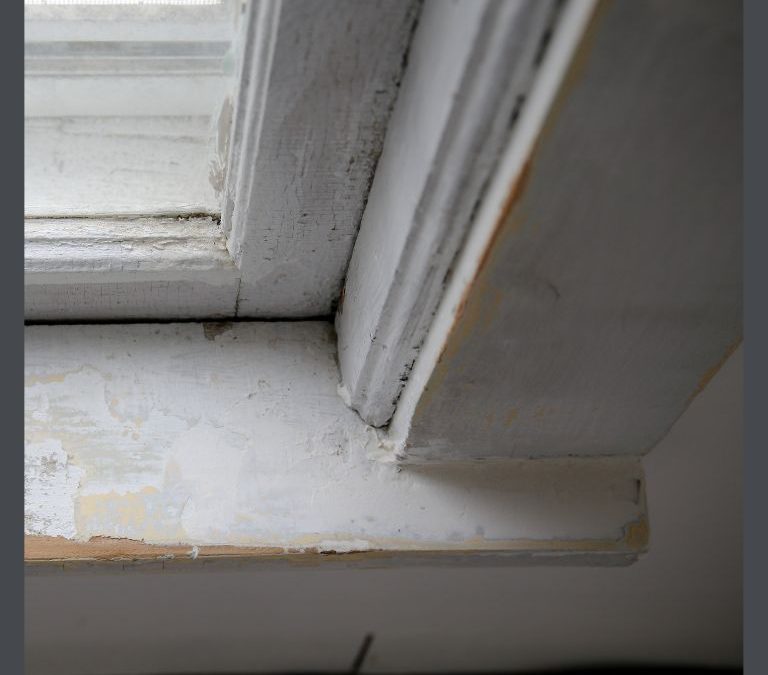
by bungalow101 | Jul 20, 2022 | Doors & windows, Why Preserve
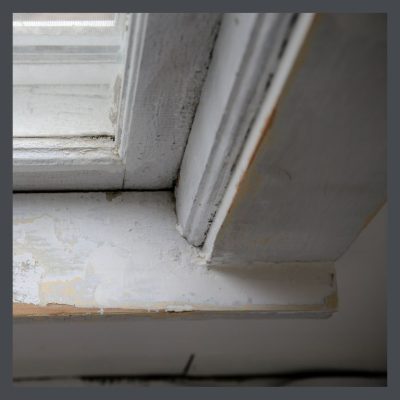 I mean really! Why is it such a big honkin’ deal to preserve your bungalow wood windows? If you’re lucky enough to have wood windows in your bungalow that aren’t painted shut, the dang ropes are broken, the wood is rotting & there’s a cracked pane or two. Rain is getting in, maybe it has for some time. Not to mention heat & cold. What’s to preserve?
I mean really! Why is it such a big honkin’ deal to preserve your bungalow wood windows? If you’re lucky enough to have wood windows in your bungalow that aren’t painted shut, the dang ropes are broken, the wood is rotting & there’s a cracked pane or two. Rain is getting in, maybe it has for some time. Not to mention heat & cold. What’s to preserve?
And people are so vehement about it, either way. On the old house FB groups there’s a ridiculous amount of high volume contention coming from both sides. And I don’t believe any claims made about the loose morals of anybody’s mother.
Anyway, it’s so-o-o-o easy to just pick up the phone, call a Big Box store (or one of the window companies that relentlessly pop up on your phone because you have searched for window solutions) & presto, you can get nice new ones installed, maybe even out of a fabulous new, no-maintenance material- vinyl. They provide the product, the labor & a 15-year warranty. With increased R-value. And you can pay with a credit card. Poof! Good-bye to peeling, leaking, moldy windows in your lovely bungalow!
SORRY, BUT HERE’S WHY YOU SHOULD PRESERVE YOUR BUNGALOW WOOD WINDOWS
 The Preservation Brief 17 of the Heritage Preservation Services’ section of the U.S. Department of the Interior, is called, “Architectural Character—Identifying the Visual Aspects of Historic Buildings as an Aid to Preserving their Character.” It provides a process to identify the visual characteristics that give a building its unique style- Dutch Revival, Colonial, Mid-Century or, tah-dah!- a bungalow. It explains how the visual character is most frequently determined by the often-related surface qualities of the materials & craftsmanship. The original choice of materials often plays the dominant role in determining an architectural style.
The Preservation Brief 17 of the Heritage Preservation Services’ section of the U.S. Department of the Interior, is called, “Architectural Character—Identifying the Visual Aspects of Historic Buildings as an Aid to Preserving their Character.” It provides a process to identify the visual characteristics that give a building its unique style- Dutch Revival, Colonial, Mid-Century or, tah-dah!- a bungalow. It explains how the visual character is most frequently determined by the often-related surface qualities of the materials & craftsmanship. The original choice of materials often plays the dominant role in determining an architectural style.
Well, old bungalow wood windows are made of exactly that- wood. An added factor to this is that they are made of old growth wood which is harder, denser & more rot resistant than any windows made today out of farmed, quick-growth wood. They have a particular set of lite patterns & they operate in the same fashion.
But none of this solves your own peeling, leaking, moldy problem so let’s see if I can help.
HOW TO FIND PROFESSIONAL WOOD WINDOW RESTORERS
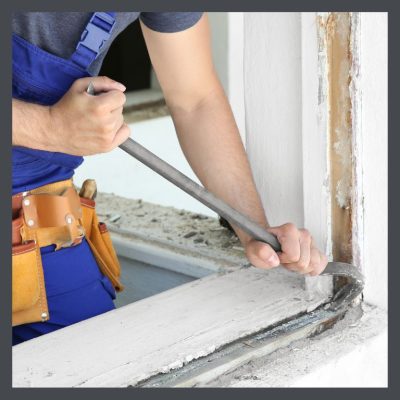 These are some dedicated folk who live their lives in service of old windows. How do you find one? Or for that matter, any tradesperson sensitive to historic materials?
These are some dedicated folk who live their lives in service of old windows. How do you find one? Or for that matter, any tradesperson sensitive to historic materials?
1. Live in an old neighborhood? You probably have a neighborhood association that could offer suggestions. If you don’t know if there is one, your City website can tell you. They usually have neighborhood departments. If you don’t find one, try groups in nearby historic areas.
2. Call your local historic preservation advocacy group. I have a woefully incomplete list of them here, but promise that I am working on expanding it.
3. Call your city preservation office for referrals. If you don’t have one, try county or state.
4. The old stand-by- Google. As with all the ablove sources, it is important to have some knowledge of wood window repair before you start to talking to repair companies. They will appreciate your interest & be better able to help you understand what they will be doing. You’ll be better able to ensure that you get the project that you want.
5. SEE JOHN LEEKE’S BOOK BELOW.
In his book, John Lists over 200 wood window repair pro’s all over the U.S.
DIRECTORY OF WOOD WINDOW PRO’S
 Wood Preservation Alliance
Wood Preservation Alliance
A group formed to help homeowners who wish to save their windows with professionals who can provide the needed services. They also offer great information on window restoration & train the pro’s in further mastering the trade. They have a page in which you can enter your state & find windows professionals. Many of these guys work in more than one state & even those who don’t are not usually opposed to traveling.
These tradespeople tend to be booked far in advance so I would suggest that you contact them even before you have an executed contract on your house. I have included DIY information for you in case you get tired of waiting. I always encourage people to learn about the various trades required to keep an old house in good shape. You’ll get a better project & you will just feel better about old house stewardship.
John Leeke’s book below also includes a directory.
As always, use my tips on hiring a contractor to minimize your risk, as well as your own perceptions, experience & smarts when you choose the people for this task. I don’t know these people & I’m not recommending them, just pointing!
LEARNING HOW REPAIR THE WOOD WINDOWS IN YOUR BUNGALOW
I am not a hands-on preservationist, but I am a maniac researcher, so when I needed to preserve my bungalow wood windows, I got help from the pro’s to teach my carpenter how to do it. So, here’s how you can learn & either DIY or, teach someone else with a greater strength & a higher aptitude for construction & more of a willingness to get dirty.
I strongly recommend that anyone hiring a professional know something about the process so you will experience fewer surprises. It will also help you understand the high price tag of this exacting, multi-step process. Or, you could teach your handy-man!
BOOKS ON HOW TO PRESERVE WOOD WINDOWS
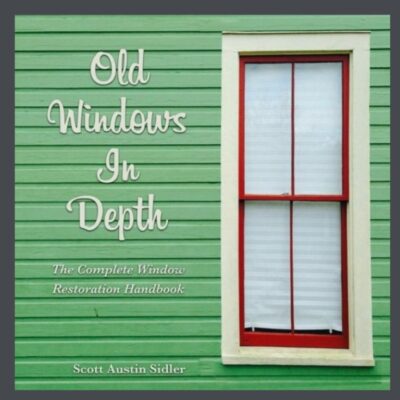 Old Windows In-Depth
Old Windows In-Depth
by Scott Sidler
Scott is a master preservation professional & has written a detailed guide on window restoration. The guide is a clearly written, tutorial showing each tiny step written for the homeowner.
Old Windows In-Depth is nearly 200 pages of picture filled tutorials detailing all of the major information that you’ll need to successfully restore any historic wood or steel window.
The predecessor to this book is the one I used to teach my carpenter how to repair my windows. Scott is very aware of all the little crunchie bits that go into restoring a window that are part of his DNA (Sorry if that’s a weird picture.) but are totally new to us. We didn’t run into any mystery parts or steps that just didn’t work. Learning from Scott’s materials was smooth as silk.
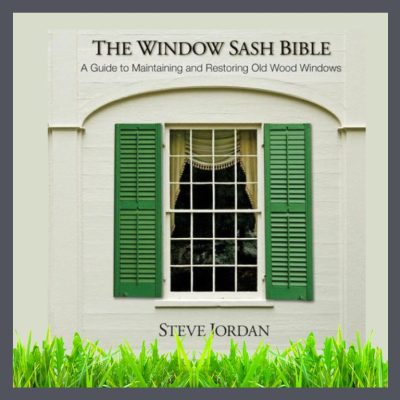 The Window Sash Bible
The Window Sash Bible
by Mr. Steve Jordan
Read this book to learn why most replacements are unnecessary & why your existing windows will serve you better than any replacements.
Whether you are a homeowner hiring tradesmen, or a DIY-er, this book will teach you how to evaluate your windows & plan & execute the needed repairs.
The book introduces you to the history of windows & teaches you about all the pieces & parts so that you can discuss your windows with tradespeople & fully understand what they are telling you about them.
The basics of wood repair are explained in detail from removing sashes, to installing sash cords to, to replacing glass & muntins to weather-sealing.
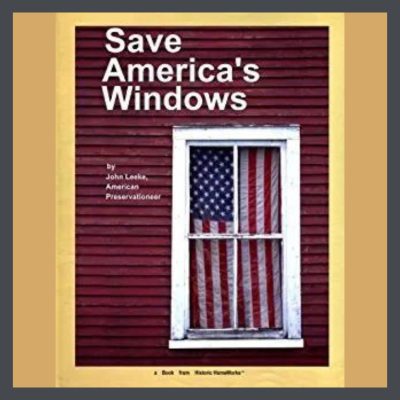 Save America’s Windows
Save America’s Windows
by John Leeke
177 pages, 257 illustrations.
John is the O.G. of wood window repair as well all the other trades related to historic preservation.
This book is the new, 2013 edition which covers the newest in high-tech window materials & techniques in addition to traditional methods. He gives you step-by-step instructions in how to maintain & how to repair old wood windows.
Here’s another cool part: He includes a National directory of 200+ window specialists who know how to repair your windows instead of selling you cheap quality windows that you will have to replace in a decade.
And another: If you follow this link, you can request for him to send you digital downloads that you can you right now.
Dare I add one more? He includes his phone number so that you can order directly from him & ask him any questions plaguing your mind about windows.
You’re welcome.
ON-LINE WOOD WINDOW RESTORATION LEARNING
 The Craftsman Blog
The Craftsman Blog
The Window Course, a step-by-step course to teach you everything you need to successfully restore historic wood windows. You’ll get written posts and dozens of videos for every part of the process. You can see a preview on this page. It shows printed steps & a video demonstrating his tried & true techniques.
Scott offers 3 packages, the most comprehensive of which is about ½ the price of having a window professionally restored. Now, like my own delicate self, you may have an aversion to getting your hands dirty & want to hire someone. You still need to know how to do this! There are many trades for which you will hire people on blind faith & Google reviews, & have no clue whatsoever about the quality of their work. This is not one of those trades. You can learn this & I suggest that you do before you fork over good money to a stranger.
As I mentioned, I used Scott’s book to teach a carpenter how to do this & I learned right along with him. Had Scott offered this video & book package then, I would have bought the ‘spensive one to gain the certainty that would have made the project less overwhelming.
SCHOOLS/WORKSHOPS
Many local preservation organizations offer workshops in wood window restoration. I recommend that you become a member so that you can stay informed of every program that they produce or promote. Follow me on Facebook because I try to announce workshops of various topics there.
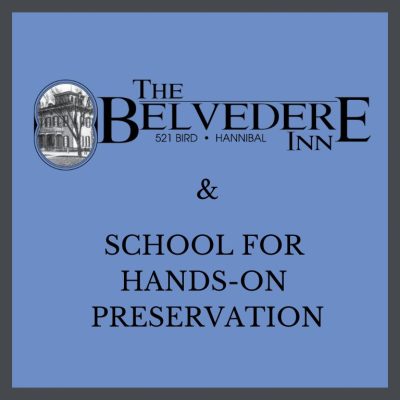 Belvedere School for Hands-On Preservation
Belvedere School for Hands-On Preservation
Hannibal, Missouri
For decades Bob Yapp has delivered hands-on preservation workshops all over the U.S. In 2008 he founded the Belvedere School in Hannibal, Missouri where he trains students to be artisans in the historic preservation trades.
His school is housed in a 5-story. 7,950 square foot 1859 Italianate house which was in deplorable condition when he discovered it. He has used it as a laboratory to teach students hands-on restoration skills. Now that the house is mostly restored, itself is mostly restored, his students now do the hands-on work on their neighbor’s neighbor’s historic houses in the Central Park National Historic District in Hannibal, Missouri.
If you are ready for a totally immersive experience, attend a workshop at whatever level of physicality suits you. Stay at his wife’s bed & breakfast in the restored house, play billiards in the parlor & fortify yourself for the workshop day with a delightful homemade breakfast.
Craftwork Training Center
History Reveals Methods and Materials which are Lasting.
We Teach using Knowledge, Time, and Practice to perfect your art.
Telford, Pennsylvania
Hosted by LimeWorks, a masonry material manufacturer, Craftwork Training Center holds training workshops throughout the year to teach people to properly use their products & to understand proper architectural restoration of masonry- plaster repair, repointing brick & stone, surface repair.
They also have workshops that teach the skills needed to restore & repair wood windows.
Their objective is to educate people so that they can enter the trades as professional & earn a good living, however, their classes are appropriate for a homeowner. Give them a ring to find out if any particular classes would be right for your skill level.
 YOUTUBE
YOUTUBE
I have saved some great videos to my channel, many of them made by the experts mentioned about. This is a great way to get oriented to the subject of wood window repair. Watch several of them! Paired with a book, you’ll earn your degree in wood window repair.
I also have many videos on many preservation subjects, each one teaching you more about your bungalow, it’s history, its construction, its possibilities.
BACK TO YOUR BUNGALOW WOOD WINDOWS
Yes, I think that you ought to restore them. If they are past the point of no return, you can build new ones using old growth lumber which is harder, denser & resists rot to a greater degree than quick growth, farmed, newly harvested wood. You can generally get this wood from a local salvage yard & have it milled into window pieces that you or your handy carpenter can join yourselves. Carefully save the glass from the old windows to install into the new frames. Both you & the kitties will enjoy that wavy glass view into the garden.
TIP: TO FIND OUT MORE ABOUT OLD GROWTH WOOD, WATCH SOME GREAT VIDEOS HERE.
 STAY IN THE BUNGALOW KNOW!!!
STAY IN THE BUNGALOW KNOW!!!
Sign up for our newsletter & receive our FREE E-book, 7 VITAL Things to Do Before You Hire a Contractor.

by bungalow101 | Jun 15, 2022 | Doors & windows, Other areas
 The subject of bungalow window coverings & the resources where they can be found is much debated, but is actually pretty simple. Nobody wants to cover their beautiful window moldings, but blocking the sun is generally desired & blocking passing eyeballs is highly recommended!
The subject of bungalow window coverings & the resources where they can be found is much debated, but is actually pretty simple. Nobody wants to cover their beautiful window moldings, but blocking the sun is generally desired & blocking passing eyeballs is highly recommended!
Jane Powell used to joke that the Revival has lo-o-ong out-lasted the original Arts & Crafts Movement. Well, yeah, but it has brought us some amazing craftspeople & I must admit that my favorites are those working in textiles. In the right hands, a bit of fabric, a snip of thread or a bit of paint can create astonishing window art.
Textile art is something that you can learn to do yourself. When I was a hippy, way back in the early 70’s, I loved to embroider, learning from books & the artistry of my friends. You can tote your work around with you & no one ever seemed to mind that I’d pick it up mid-conversation. (Of course, we were pretty mellow those days.)
I have included here textile artists, all well-known for their work, who offer window treatments. They also offer complimentary items such as pillows, table runners & upholstery covers. Of course it is not mandatory to have adornment on your curtains because the beautiful fabric & even the lovely hem work will enhance any room in which you use them.
Several of these artists offer stencil & embroidery patterns, & I’ll be including links to others who deal in only those goods, so if you want to create your own embellishment, you can do so. I would love to see what you make, so please send me images of your homes with your lovely new blinds!!
Hardware is also a tricky issue so I have included harware sources below. I’m a bit of a hardware addict, & when I needed to replace some of the hardware in the Hare House, I formed a friendship with my hardware specialist & 20 years & 3 houses years later, we get together when she visits her sister in St. Pete. We can spend hours on the phone talking hardware & I have been nagging her to write a book on doorknobs.
HERE ARE YOUR BUNGALOW WINDOW COVERINGS RESOURCES!
 Ann Wallace For Prairie Textiles/melton Workroom
Ann Wallace For Prairie Textiles/melton Workroom
Ann carries a full line of custom made window treatments-curtains, Roman shades, roller shades- in a variety of appropriate fabrics. She offers either stenciling or embroidery & will help you to choose the best combinations. She has a lovely collection of embroidery choices to best complement your home.
If you want to stencil your own designs, she has the stencils, brushes & the paints. I have always lovely thistles- even once named a kitty Thistle! And, she has all the hardware that you would need to install your wonderful new window treatments. She’ll also make you pillows, runners & bedspreads to match or complement!
 Arts & Crafts Period Textiles
Arts & Crafts Period Textiles
From The Workshop Of Diane Ayers
In addition to her custom, hand-made wares, Diane features antique textiles also which combine beautifully with newly made pieces & can serve as great inspiration. She also carries antique books about the Arts & Crafts period, most on the topic of design.
Diane’s website takes you step-by-step through planning your order, being with lifestyle requirements. She continues with fabric descriptions & choices, embellishment offerings & discusses the need for lining. You can also purchase beautiful & appropriate fabric from her to make your own curtains.
She has some great information & clear illustrations to demonstrate mounting choices & shows mounting hardware in her catalogue.
 From The Studio Of Natalie Richards
From The Studio Of Natalie Richards
Natalie is a Roycroft Renaissance Artisan. This designation is awarded only to those who demonstrate high quality hand-craftsmanship, excellence in design, continuing artistic growth & originality of expression.
On her site, she provides an explanation of the different curtain types/choices that exist. She also describes many fabric types. It’s a good, basic lesson.
Natalie offers curtains in a great assortment of fabrics with a number of finishes. She also has embroidered & stenciled pillows & embroidered table runners as well as kits for these items. In addition, you can purchase fabric from her as well as embroidery supplies.
Morris & Co.
This British company recreates William Morris’ designs in beautiful fabric, wallpaper & paint, in lush colors to complement a more formal home. When I chose fabric for the Hare house, I was not aware of this resource. I liked the fabric I chose, but I would have been much happier with the patterns I saw in my books about Morris.
Unfortunately, their products cannot be purchased online, so you’ll need to use their search feature to locate a retailer near you. Howver, what could be bad about visiting these lush colors & patterns?
Morris’ designs represent the philosophical & aesthetic inspiration for your bungalow. Even if they are not appropriate in your more casual, American Craftsman home, they are an important part of its history with their interpretations being expressed in every feature.
 Cooper Lace
Cooper Lace
Cooper Lace offers 100% cotton, Scottish-woven sheers & sidelights in a variety of Arts & Crafts patterns. My favorite, of course, because it enhanced the windows of the Hare House, is their Voysey, The Stag, but there are several others which would complement your bungalow, giving you varying degrees of light penetration & privacy. The image is of the Ginkgo Leaf, a revered & oft-repeated image in the Movement.
Alameda Shade Shop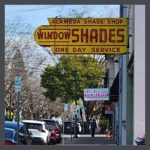
Pull-down blinds are what you want to have in your bedroom. They can be used alone, with a valence, behind lace or other open-weave fabrics.
While there are a great number of Victorians on their site, they do offer a plain hem with a ring pull, in cotton. (Just waiting for you to add your own flair with a custom, stenciled design!) Their room darkening, fire retardant, washable blind is offered in 3 neutral tones. Each blind is custom made to your specifications. They even offer laminations, using your own fabric and which they apply to their blackout fabrics.
If you are in the San Francisco Bay area, they can offer you more choices in their gallery.
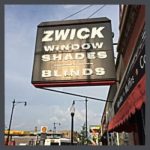 Zwick Window Shade Company
Zwick Window Shade Company
Founded in 1930, Zwick is in its third generation as a family business, manufacturing handmade custom shades in their Chicago workshop.
Each shade is made to your exact specifications. They’ll re-cycle your old rollers to use them for your new shades & give you a discount! From their Build Your Custom Window Shade feature, you can choose the mundane details such as measurements & also the more entertaining ones such as fabric, trim & pulls. And, they include mounting hardware.
BUNGALOW WINDOWS-STENCILS
There are many books available that provide stencil patterns & ideas for patterns should you choose to create your own, as well as vendors that feature ready-cut ones.
 Trimbelle River Studio & Design
Trimbelle River Studio & Design
Vintage stenciling from the Arts & Crafts Movement
Trimbelle River is a complete resource for stencils. They provide a large & beautiful variety of designs- floral, geometric, very large, as well as supplies such as brushes.
These wonderful folks have partnered with Northeast Contemporary Services, Inc. a group of adults with intellectual and developmental disabilities & promote their stenciled items. You can sign up to be notified for their sales via Trimbelle River’s website.
BUNGALOW WINDOW COVERINGS RESOURCES- HARDWARE
 Rejuvenation Hardware
Rejuvenation Hardware
Rejuvenation offers single mounting sets & also rings in several finishes. They also have metal tiebacks that you can mount to hold back your curtains. These are handy because you’re not going to want to use ornate fabric tie-backs on the simple window dressings.
 Historic Houseparts
Historic Houseparts
This vendor offers- well-everything! In addition to my vintage appliance addiction, I am mesmerized by old hardware & promise you will get lost in this site. That’s why I sent you directly to the curtain hardware section. I’m trying to help.
They carry single & double mounts, rods & a beautiful assortment of glass tie-backs.
I have many textile images on my Pinterest page so you can see the work of these very skillful fabric artists & others.
 STAY IN THE BUNGALOW KNOW!!!
STAY IN THE BUNGALOW KNOW!!!
Sign up for our newsletter & receive our FREE E-book, 7 VITAL Things to Do Before You Hire a Contractor.
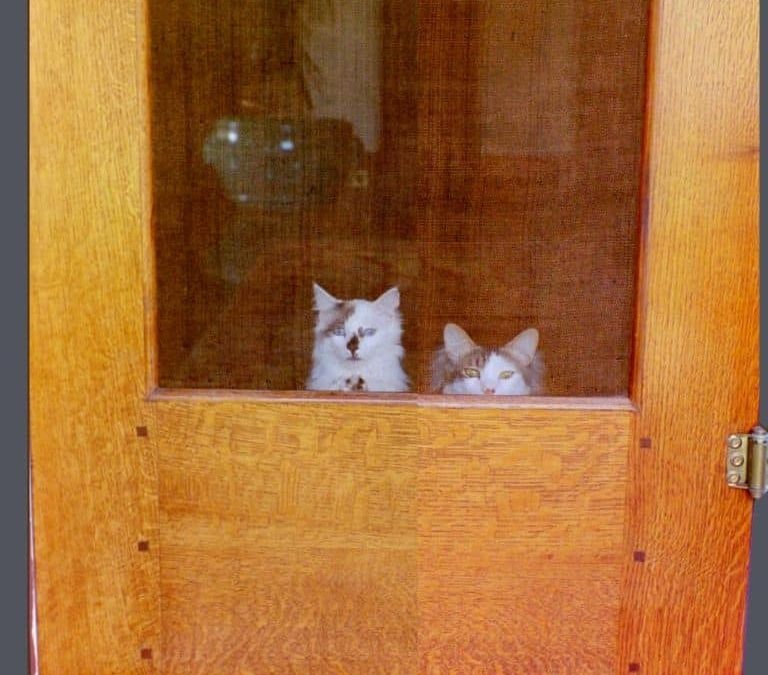
by bungalow101 | May 17, 2022 | Doors & windows
 Doo, doo, doo, lookin’ out my custom made, tiger oak, square pegged, brass mesh, bungalow screen door.
Doo, doo, doo, lookin’ out my custom made, tiger oak, square pegged, brass mesh, bungalow screen door.
Meet Mahjong the Amazing Wonder Kitten (furry face on the left) & his bro, Bukhai Thunder, on the right. When you have pussycats, it is a good idea to have a screen door so that they can experience nature without experiencing nature. We had ours at the Hare House custom made out of quartersawn white oak. We hand-picked the wood & chose where it would be placed. The bottom rail is 2 planks, heavily figured in a lose pattern. The top is 1 plank of the same heavy, large figuring. The side rails are less heavily figured. I do not like an object that has too much figuring. I feel like it doesn’t give you the opportunity to focus & can end up looking like porcupine with bedhead.
Our bungalow screen door is joined by mortise & tennon but we added decorative plugs of walnut, a darker wood. The mesh is brass, a traditional material. The screen is applied to a rabbet in the front of the door. We finished it with a oil-based poly, probably a floor finish because that’s what we do! We chose not to stain it because this type of finish ambers over time & we knew that it would get much darker.
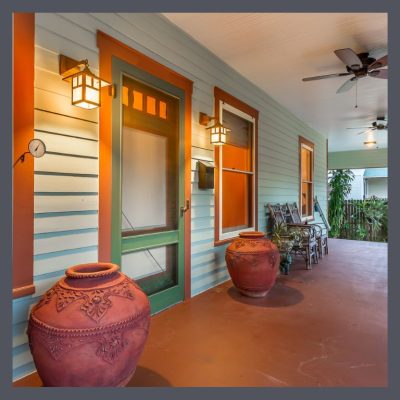 Bungalow doors & screen doors are most often made of a higher grade wood, generally oak, & clear-coated, but sometimes both are painted. You want them to have the same finish.
Bungalow doors & screen doors are most often made of a higher grade wood, generally oak, & clear-coated, but sometimes both are painted. You want them to have the same finish.
My Tampa house had a Victorian looking door when I bought it & we replaced it with a pine door that I zhuzhed up with way too many colors. I then got a salvaged screen door that had already been painted, & chose for it also, one of the way too many colors on the door, as well as adding some pieces to stabilize it. It was not as heavy as my oak screen door, & was already 100 years old. The poor door was always a bit wobbly & I was a little concerned the one time I told someone, “Don’t let the screen door hit you on the a$$,” but it was really appropriate at the time. I expect the chunky oak at the Hare House one will hang in there for another 100 years.
For the oak, we chose heavy, reproduction brass hinges & pull. For a lock, I used a simple hook & eye inside. I used a vintage reproduction doorknob on the painted pine screen door, but the oak is rather chunky & the knobs tend to be rather delicate, both in look & in function. The good thing about the knobs is that they do have a locking mechanism & if you make friends with your hardware specialist, she will teach you how to keep them operational.
The hinges have a spring in them that you can calibrate to customize the strength of the door swing so that they will be easy to open, & will self-close without whacking you. You have to fool around with them for a bit to figure out the swing pressure. And then calibrate the second one so that you don’t have a wobbly door.
It is not difficult to build a beautiful screen door. My YouTube channel has many videos about the care & feeding of bungalows. You (or your carpenter/handyman) can learn how to make an authentic screen door here.
THE BEST PART OF A BUNGALOW SCREEN DOOR- THE CAT!
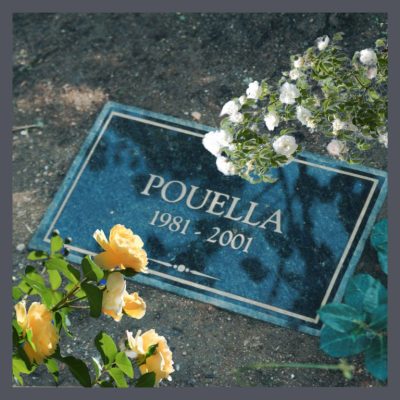 My elderly Pouella moved into the Hare House with us, got to see the beginning of the third millennium on the lap of a dear friend devoted to kitties, & is now buried in the garden under the David Austen roses with a little kitty-cat plaque. She had been sliding downhill fast & I asked her to please hang on until Home Tour so that I could help pull off this important neighborhood event. The day of Home Tour came. She could not rise from her little nest on the floor. She very clearly said, “Ok, Mom. I made it to Home Tour day. Now, can I go?” We zipped her over to the vet & her beloved Daddy, my wonderful husband held her as she drifted away.
My elderly Pouella moved into the Hare House with us, got to see the beginning of the third millennium on the lap of a dear friend devoted to kitties, & is now buried in the garden under the David Austen roses with a little kitty-cat plaque. She had been sliding downhill fast & I asked her to please hang on until Home Tour so that I could help pull off this important neighborhood event. The day of Home Tour came. She could not rise from her little nest on the floor. She very clearly said, “Ok, Mom. I made it to Home Tour day. Now, can I go?” We zipped her over to the vet & her beloved Daddy, my wonderful husband held her as she drifted away.
At Home Tour everyone asked about her. Not wanting to ruin the committee’s day, I told them all that she was just fine. Home Tour saved me. I got to spend the day with my dearest friends at my favorite activity & the joy of the event buoyed me for going home to no Pouella.
After a period of mourning, during which I moved numbly about my house all day, crying much of the night, one day I woke up, strangely free of the grief that had held me. New kitten day had miraculously dawned! I called my friend Joanne who at Pou’s memorial service, had offered to come with me to choose the newbie and she was at my door in about 3 minutes. (One of the beauties of neighborhood activism- all your friends live real close!)
THE NEW BUNGALOW KITTY
 We trotted into the Pasadena Humane society & there he was- 2 lbs. of wild man- my bouncing, squeaking (He never did develop a proper meow.) cage rattling, blue-eyed boy, who had arrived that morning from foster care. The facility was closing soon, so I couldn’t adopt him that day. We stayed playing with him until sternly asked to leave. I was emphatically told that it was first come, first served, so I should be sure to come early.
We trotted into the Pasadena Humane society & there he was- 2 lbs. of wild man- my bouncing, squeaking (He never did develop a proper meow.) cage rattling, blue-eyed boy, who had arrived that morning from foster care. The facility was closing soon, so I couldn’t adopt him that day. We stayed playing with him until sternly asked to leave. I was emphatically told that it was first come, first served, so I should be sure to come early.
They opened at 9 the next morning. I had been there with my carrier since 7. When the first volunteer arrived at 8:59, I ran at her yelling, “See, I’m here first. He’s mine!!!!”
He truly was. I brought him home to the Hare House & locked us in the study, the smallest room in the house, so he could get accustomed to his new surroundings. This tiny bundle of fur sniffed the entire floor- rugs, chair legs, fireplace, bookcase, with his tiny super-vacuum nostrils. Satisfied, he hopped up on the desk, speed dialed a couple folks, & sent a fax. Then he looked at me, hopped down & sat by the door, craning his little neck to look up at the doorknob, squeaking. And squeaking. And squeaking.
Later that day, tired from exploring the whole house, he purred on my bosom. I told him, “Thank you for mending my broken heart.”
He answered, “Thank you for mending mine. I missed my mother.”
He had been in foster care for several weeks getting enough weight on him to be adopted. One of the great mysteries of my life is how the foster mom could have given him up.
I guess it was so that I could wake up one morning, from blocks away, hear his tiny squeaks for “Mom!” causing my grief to melt away, & fall in love with this amazing individual who enchants everyone he meets.
He inspires me every day with his joyous spirit, unflagging persistence & creative intelligence. And when we moved to a new house in Florida, he got a new bungalow screen door- one with a shorter bottom rail so he could see over it without having to stand up like a prairie dog. “Thanks, Mom.”
TIP: READ ABOUT BUKHAI THE BIGHEARTED BUNGALOW CAT HERE.
 STAY IN THE BUNGALOW KNOW!!!
STAY IN THE BUNGALOW KNOW!!!
Sign up for our newsletter & receive our FREE E-book, 7 VITAL Things to Do Before You Hire a Contractor.

 If you should be fortunate enough to have a bungalow, architectural salvage can be your BFF. Merriam Webster defines salvage as “property saved from destruction in a calamity (such as a wreck or fire).”
If you should be fortunate enough to have a bungalow, architectural salvage can be your BFF. Merriam Webster defines salvage as “property saved from destruction in a calamity (such as a wreck or fire).” The footprint of architectural salvage materials is generally only that of transportation, from the original site, to the warehouse, to the new home. (hm-m-m.) I don’t think transportation is figured into the numbers for the turbine or for the panels.) This of course varies considerably so I’m not going to give you any figures on this but I think you get it!
The footprint of architectural salvage materials is generally only that of transportation, from the original site, to the warehouse, to the new home. (hm-m-m.) I don’t think transportation is figured into the numbers for the turbine or for the panels.) This of course varies considerably so I’m not going to give you any figures on this but I think you get it! STAY IN THE BUNGALOW KNOW!!!
STAY IN THE BUNGALOW KNOW!!!


 From their framing to their siding to their doors & windows to their built-ins & their flooring, our old houses, are built of old growth wood. Thousands of board feet of it.
From their framing to their siding to their doors & windows to their built-ins & their flooring, our old houses, are built of old growth wood. Thousands of board feet of it. Let’s start with the Redwood, one class being the oldest plants on earth, living from about 800 to 3,200 years. On the west coast, before they were chopped to build our houses, they played an important part in the lives of early indigenous peoples who revered them, building structures from fallen trees. Native elder Minnie Reeves called them “a special gift from the Great Creator. Destroy these trees and you destroy the Creator’s love . . . and you will eventually destroy mankind.”
Let’s start with the Redwood, one class being the oldest plants on earth, living from about 800 to 3,200 years. On the west coast, before they were chopped to build our houses, they played an important part in the lives of early indigenous peoples who revered them, building structures from fallen trees. Native elder Minnie Reeves called them “a special gift from the Great Creator. Destroy these trees and you destroy the Creator’s love . . . and you will eventually destroy mankind.” The Domesday Book of 1086, a survey ordered by William the Conqueror to record his holdings, indicated a forest cover of 15%, By the start of the next millennium, this coverage had dropped to 5%.
The Domesday Book of 1086, a survey ordered by William the Conqueror to record his holdings, indicated a forest cover of 15%, By the start of the next millennium, this coverage had dropped to 5%.  Trees are planted in man-made forests with the purpose of generating a large amount of product, fast. These farms do not replicate the ecology of the natural forest. Generally they are one species only, & all the trees are planted at the same time. The trees are planted in rows spaced to allow maximum sunlight & water exposure so they grow very fast. The old forests allowed trees to grow slowly, putting on more tightly-packed growth rings
Trees are planted in man-made forests with the purpose of generating a large amount of product, fast. These farms do not replicate the ecology of the natural forest. Generally they are one species only, & all the trees are planted at the same time. The trees are planted in rows spaced to allow maximum sunlight & water exposure so they grow very fast. The old forests allowed trees to grow slowly, putting on more tightly-packed growth rings Much of this mutual adaptation involves microorganisms, the fungi that break down the fiber of the dead trees & turn them into nutritious soil, but also form a communication network for the trees. Watch this short
Much of this mutual adaptation involves microorganisms, the fungi that break down the fiber of the dead trees & turn them into nutritious soil, but also form a communication network for the trees. Watch this short 
 I mean really! Why is it such a big honkin’ deal to preserve your bungalow wood windows? If you’re lucky enough to have wood windows in your bungalow that aren’t painted shut, the dang ropes are broken, the wood is rotting & there’s a cracked pane or two. Rain is getting in, maybe it has for some time. Not to mention heat & cold. What’s to preserve?
I mean really! Why is it such a big honkin’ deal to preserve your bungalow wood windows? If you’re lucky enough to have wood windows in your bungalow that aren’t painted shut, the dang ropes are broken, the wood is rotting & there’s a cracked pane or two. Rain is getting in, maybe it has for some time. Not to mention heat & cold. What’s to preserve? The
The  These are some dedicated folk who live their lives in service of old windows. How do you find one? Or for that matter, any tradesperson sensitive to historic materials?
These are some dedicated folk who live their lives in service of old windows. How do you find one? Or for that matter, any tradesperson sensitive to historic materials?






 YOUTUBE
YOUTUBE
 The subject of bungalow window coverings & the resources where they can be found is much debated, but is actually pretty simple. Nobody wants to cover their beautiful window moldings, but blocking the sun is generally desired & blocking passing eyeballs is highly recommended!
The subject of bungalow window coverings & the resources where they can be found is much debated, but is actually pretty simple. Nobody wants to cover their beautiful window moldings, but blocking the sun is generally desired & blocking passing eyeballs is highly recommended! Ann Wallace For Prairie Textiles/melton Workroom
Ann Wallace For Prairie Textiles/melton Workroom Arts & Crafts Period Textiles
Arts & Crafts Period Textiles

 Cooper Lace
Cooper Lace
 Zwick Window Shade Company
Zwick Window Shade Company Trimbelle River Studio & Design
Trimbelle River Studio & Design Rejuvenation Hardware
Rejuvenation Hardware Historic Houseparts
Historic Houseparts
 Doo, doo, doo, lookin’ out my custom made, tiger oak, square pegged, brass mesh, bungalow screen door.
Doo, doo, doo, lookin’ out my custom made, tiger oak, square pegged, brass mesh, bungalow screen door. Bungalow doors & screen doors are most often made of a higher grade wood, generally oak, & clear-coated, but sometimes both are painted. You want them to have the same finish.
Bungalow doors & screen doors are most often made of a higher grade wood, generally oak, & clear-coated, but sometimes both are painted. You want them to have the same finish. My elderly Pouella moved into the Hare House with us, got to see the beginning of the third millennium on the lap of a dear friend devoted to kitties, & is now buried in the garden under the David Austen roses with a little kitty-cat plaque. She had been sliding downhill fast & I asked her to please hang on until Home Tour so that I could help pull off this important neighborhood event. The day of Home Tour came. She could not rise from her little nest on the floor. She very clearly said, “Ok, Mom. I made it to Home Tour day. Now, can I go?” We zipped her over to the vet & her beloved Daddy, my wonderful husband held her as she drifted away.
My elderly Pouella moved into the Hare House with us, got to see the beginning of the third millennium on the lap of a dear friend devoted to kitties, & is now buried in the garden under the David Austen roses with a little kitty-cat plaque. She had been sliding downhill fast & I asked her to please hang on until Home Tour so that I could help pull off this important neighborhood event. The day of Home Tour came. She could not rise from her little nest on the floor. She very clearly said, “Ok, Mom. I made it to Home Tour day. Now, can I go?” We zipped her over to the vet & her beloved Daddy, my wonderful husband held her as she drifted away. We trotted into the Pasadena Humane society & there he was- 2 lbs. of wild man- my bouncing, squeaking (He never did develop a proper meow.) cage rattling, blue-eyed boy, who had arrived that morning from foster care. The facility was closing soon, so I couldn’t adopt him that day. We stayed playing with him until sternly asked to leave. I was emphatically told that it was first come, first served, so I should be sure to come early.
We trotted into the Pasadena Humane society & there he was- 2 lbs. of wild man- my bouncing, squeaking (He never did develop a proper meow.) cage rattling, blue-eyed boy, who had arrived that morning from foster care. The facility was closing soon, so I couldn’t adopt him that day. We stayed playing with him until sternly asked to leave. I was emphatically told that it was first come, first served, so I should be sure to come early.